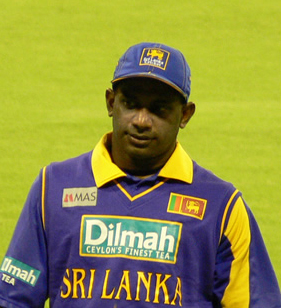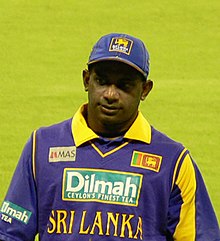
The 1996 Cricket World Cup, also called the Wills World Cup 1996 after the Wills Navy Cut brand produced by tournament sponsor ITC, was the sixth Cricket World Cup organised by the International Cricket Council (ICC). It was the second World Cup to be hosted by Pakistan and India but Sri Lanka were hosts for the first time. The tournament was won by Sri Lanka, who defeated Australia by seven wickets in the final on 17 March 1996 at the Gaddafi Stadium in Lahore, Pakistan.

Warnakulasuriya Patabendige Ushantha Joseph Chaminda Vaas is a former Sri Lankan international cricketer who represented the Sri Lanka national cricket team. He is a fast medium pace bowler and one of the most successful bowlers in international cricket.

Deshabandu Sanath Teran Jayasuriya, is a former Sri Lankan cricketer and captain, who is widely regarded as one of the greatest ever to play the game. A left arm opening batsman, an orthodox spinner and a dynamic fielder, Jayasuriya together with his opening partner Romesh Kaluwitharana is credited for having revolutionized one-day international cricket with his explosive batting in the mid-1990s, which initiated the hard-hitting modern-day batting strategy of all nations. He was a key member of the Sri Lankan team that won 1996 Cricket World Cup. Under his captaincy Sri Lanka become joint champions along with India in the 2002 Champions Trophy.
Deshabandu Roshan Siriwardene Mahanama is a former Sri Lankan cricketer and a former ICC match referee. He was a key member for 1996 Cricket World Cup winning team for Sri Lanka. He is the first man to have stood as a match referee in a day-night test match in Test history.
The Indian Oil Cup 2005 was a three-team One Day International (ODI) cricket tournament held in Sri Lanka between 30 July and 7 August 2005. The participating teams were hosts Sri Lanka, and India and West Indies. Sri Lanka won the tournament beating India by 18 runs in the final.
The Indian cricket team made its Test cricket debut in 1932 and has since advanced to be among the top four test teams in the in each of 2005 to 2008. The team won the ODI Cricket World Cup in 1983 and 2011. In other major International victories, Team India won the Twenty20 World Cup in 2007 and ICC Champions Trophy in 2002 and 2013.
The Indian cricket team toured Sri Lanka from 12 July to 14 August 1993. The tour began with a first-class fixture against Sri Lanka Board President's XI and ended with the final ODI game. In all, it consisted of one first-class game, and three Test and One Day Internationals (ODIs) each.
The Chappell–Ganguly controversy was caused by a series of events in late 2005 and early 2006 which involved highly publicised infighting in the Indian cricket team between the then newly appointed coach Greg Chappell and captain Sourav Ganguly. The dispute resulted in the removal of Ganguly as captain and his replacement by vice-captain Rahul Dravid in November 2005, with Ganguly being dropped from the ODI team. Ganguly was also dropped from the Test team at the end of January 2006. The dispute stirred up strong emotions in India, ranging from fiery street protests in Ganguly's home town of Kolkata and his home state of West Bengal, to speeches in the Parliament of India. Eventually Ganguly was recalled to the team in both forms of cricket in late 2006 after his replacements lost form, and was selected as a part of the Indian team for the 2007 Cricket World Cup.
The Australian cricket team toured India from February to April 2001 for a three-Test series and a five-match ODI series. The series is considered one of India's finest, as they secured victory against Australia in the Test series, in the process breaking Australia's 16-match win streak in Tests, and being the third side to win a Test match after being asked to follow-on during the match in Kolkata. The Kolkata match has been widely regarded as one of the greatest matches in the sport's history.
The West Indies cricket team toured Sri Lanka from 1 to 18 December 1993. The tour consisted of three One Day Internationals (ODIs) and a one off Test match. This was the first time the West Indies toured Sri Lanka, which hosted the first ever Test match between the two countries. A three-day tour match between West Indies and Sri Lanka Board President's XI was also played at the Galle International Stadium from 3–5 December.

The 2003 Cricket World Cup Final was a One Day International (ODI) match played on 23 March 2003 at the Wanderers Stadium in Johannesburg, South Africa. It marked the culmination of the 2003 Cricket World Cup, the eighth edition of the tournament. It was the first time these two teams had met at this stage of a World Cup. For defending champions Australia it was their fifth World Cup final, while for India it was the second after their 1983 victory. Australia won the match by 125 runs to claim the title for the third time.
The 1996 Singer Cup was a triangular cricket tournament held between 1 and 7 April 1996 in Singapore. The competition featured the national cricket teams of India, Sri Lanka and Pakistan. The tournament was won by Pakistan, which defeated Sri Lanka in the final on 7 April.

Deshabandu Pinnaduwage Aravinda de Silva is a former Sri Lankan cricketer and captain, who has also played in English county cricket. De Silva was a key member of the Sri Lankan team that won 1996 Cricket World Cup, where he scored a match winning century in the final, that brought Sri Lanka from underdog status to present-day form. He has held various posts in Sri Lankan Cricket after his retirement in 2003. He was inducted into ICC Cricket Hall of Fame in 2023.
The Titan Cup was a triangular One Day International cricket tournament held in India between 17 October and 6 November 1996 involving South Africa, Australia and India. Although South Africa had won all its round-robin matches, it lost in the final to India. The tournament was sponsored by and named after Titan Industries.
The 1997 Pepsi Independence Cup was a quadrangular ODI cricket tournament held in May 1997 to commemorate the 50th anniversary of the independence of India. It featured the national cricket teams of New Zealand, Pakistan, Sri Lanka and the hosts India. The tournament was won by Sri Lanka, which defeated Pakistan in the best-of-three finals. Sri Lanka became the Champion.
The Sri Lanka national cricket team toured India during the 1997–98 cricket season, playing three Test matches and three One Day Internationals (ODIs). Both series were drawn; all three Tests were draws, and each side won one of the ODIs, tying the series 1–1. The other ODI, which was held on 25 December, was abandoned after three overs had been bowled, when after discussion between the two captains and the match referee, it was determined that the inconsistent bounce of the pitch was too dangerous for the players. This was the first occasion on which an international cricket match had been called off for this reason.
In the 1982–83 cricket season, the Sri Lankan national cricket team toured to India to play the Indian national cricket team. The tour included one Test match. That match was drawn. Three players scored centuries; Duleep Mendis scored 105 in both Sri Lankan innings, and Sunil Gavaskar and Sandeep Patil scored 155 and 144 respectively, both in India's first innings. Three players took a five-wicket haul in the game; Dilip Doshi took five wickets for 85 runs in Sri Lanka's first innings, Kapil Dev took five wickets for 110 runs and Ashantha de Mel took five wickets for 68 runs.
The Australian cricket team toured India from February to April 1998 for a three Test series and an ODI tri-series featuring Australia, India and Zimbabwe.
The History of the Sri Lanka national cricket team began with the formation of the Colombo Cricket Club in 1832. By the 1880s a national team, the Ceylon national cricket team, was formed which began playing first-class cricket by the 1920s. The Ceylon national cricket team had achieved associate member status of the International Cricket Council in 1965. Renamed Sri Lanka in 1972, the national team first competed in top level international cricket in 1975, when they played against West Indies during 1975 Cricket World Cup; West Indies won the match by 9 wickets at Old Trafford, Manchester, England.






